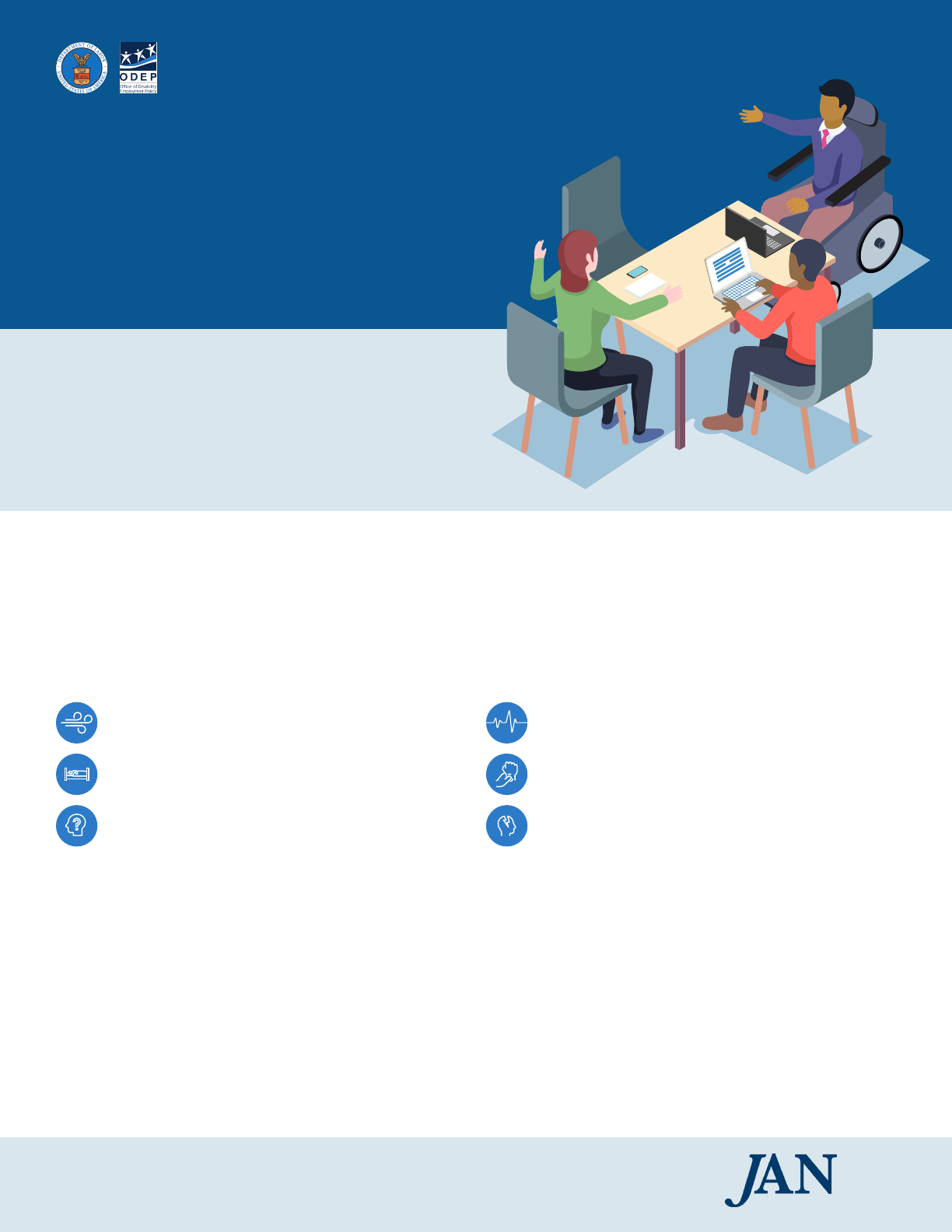
At the U.S. Department of Labor, we’re committed
to supporting individuals experiencing Long
COVID and its related conditions who want to
keep working or return to work.
Working with
Long COVID
Supporting Workers with Long COVID
According to the Centers for Disease Control and Prevention, some people who had COVID-19 experience a range of new
or ongoing symptoms, known as post-COVID conditions or Long COVID, that can last weeks, months, or years, and can
worsen with physical or mental activity.
Common symptoms include, but are not limited to:
OFFICE OF DISABILITY EMPLOYMENT POLICY
UNITED STATES DEPARTMENT OF LABOR
Shortness of breath or difculty breathing
Tiredness or fatigue
Difculty thinking or concentrating
(sometimes called “brain fog”)
A person with Long COVID may have a disability and be entitled to accommodations under the Americans with
Disabilities Act, if the person has a physical or mental impairment that substantially limits one or more major life activities.
Workers may have difculty working the same way they did before and may be entitled to temporary or longer-term
supports that can help them stay on the job or return to work once ready.
To learn more, contact the Department’s Job Accommodation Network (JAN)—the leading source of free, expert,
and condential guidance on workplace accommodations and disability employment issues. In addition to one-on-one
consultations regarding specic situations, JAN offers a series of guidance documents on workplace accommodations for
people with Long COVID and associated conditions.
Fast-beating or pounding heart
(known as heart palpitations)
Joint or muscle pain
Headaches
Job Accommodation Network
AskJAN.org

Examples of accommodations for common symptoms of Long COVID and its related conditions.
Shortness of breath or difculty breathing
→ Reduce the physical demands of the job
→ Allow rest breaks
→ Reduce workplace triggers
→ Allow time for medical treatment such as use of a
nebulizer or inhaler
→ Restructure the job to remove marginal job functions
→ Develop a plan of action to deal with sudden
exacerbations
→ Provide an alternative mask
→ Allow removal of mask when appropriate
→ Allow telework
→ Allow leave for treatment
Tiredness or fatigue
→ Allow rest breaks
→ Provide an ergonomic workstation
→ Allow a exible schedule
→ Restructure the job to remove marginal job functions
→ Allow telework
Difculty thinking or concentrating (sometimes called
“brain fog”)
→ Provide a quiet workspace
→ Allow use of noise cancellation or white noise
→ Provide uninterrupted work time
→ Provide memory aids such as owcharts and checklists
→ Allow the use of apps for concentration, memory, and
organization
→ Allow rest breaks
→ Restructure the job to remove marginal functions to
allow focus on essential job duties
→ Allow telework
Depression or anxiety
→ Allow a exible schedule
→ Allow rest breaks
→ Provide a rest area/private space to manage symptoms
→ Allow a support animal
→ Allow a support person
→ Identify and reduce workplace triggers
→ Allow leave for treatment
Insomnia
→ Allow rest breaks
→ Allow a exible schedule
→ Keep the workstation temperature on the cool side
→ Allow cold drinks at the workstation
→ Allow telework
Fast-beating or pounding heart (known as heart
palpitations)
→ Allow rest breaks
→ Control the workstation temperature
→ Provide an ergonomic workstation
→ Allow drinks at the workstation
→ Develop a plan of action to deal with sudden
exacerbations
→ Allow telework
→ Allow leave for treatment
Joint or muscle pain
→ Allow rest breaks
→ Reduce the physical demands of the job
→ Provide an ergonomic workstation
→ Allow a exible schedule
→ Restructure the job to remove marginal job functions
→ Allow telework
→ Allow leave for treatment
Headache
→ Reduce workplace triggers
→ Provide alternative lighting
→ Reduce glare
→ Allow a exible schedule
→ Allow telework
Job Accommodation Network
AskJAN.org
OFFICE OF DISABILITY EMPLOYMENT POLICY
UNITED STATES DEPARTMENT OF LABOR
